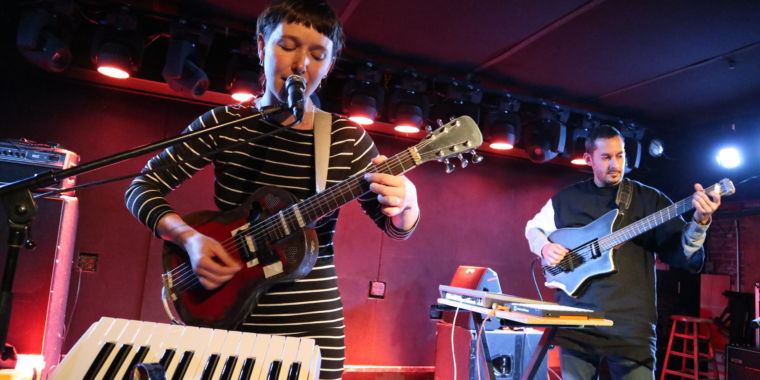
-
L-R: Arone Dyer and Aron Sanchez perform as Buke and Gase in November 2018. Each holds one of the band’s titular, custom-built instruments: a baritone ukulele and a guitar-bass fusion.
Sam Machkovech -
Sanchez’s seated position lets him activate the bass-drum switch with one foot and adjust samples with the other.
-
Dyer relies more on this tambourine-fused shoe to add percussion, depending on the song.
-
The other stuff that Dyer hits with her feet during a live performance. She’s mostly focusing on the four big buttons, since the rest of the controls are handled on the fly…
-
… by this laptop rig. It does not play pre-recorded samples. Instead, it sends customized settings to each pedal and sample switch for every song. It’s effectively the band’s setlist.
-
Sanchez’s rig has a similar, custom-built switch with giant, arcade-game buttons.
-
Dyer switches from her “buke” to a rig of keyboard and touchscreens.
-
Buke and Gase, facing off.
NEW YORK CITY—The band brings to the stage: two grids of foot-triggered effects pedals and switches; two music stands, covered with a smattering of synthesizers, touchscreens, and touch-sensitive pads; two laptops, connected to this variety of inputs in a center console; two stringed instruments, neither of which look exactly like a bass or a guitar; and two foot-triggered pieces of percussion.
One of those is a compact kick-drum rig, connected to that array of laptops. The other is a bicycling shoe with tambourine parts welded onto its sides and sole.
This pre-show array of gear usually elicits curious looks from crowds who wonder what kind of noise is about to emerge. But the band Buke and Gase are here for a homecoming show of sorts. They’re fresh off a nationwide tour with Shellac, among the esteemed post-punk bands to have ties to the genre’s original DIY movement. They’ve just put the final touches on their new album, titled Scholars, set to launch two months later (as in, January 18). People are here to celebrate.
So the people in the crowd are mostly fans who are familiar with Buke and Gase’s unique attributes, who’ve heard the band’s critically acclaimed albums and seen them play concerts with some of indie rock’s biggest names. They’ve seen those custom-built instruments before (a baritone ukulele and fused guitar-bass—hence, the band’s name). The fans already know that the duo, Arone Dyer and Aron Sanchez, has built their mix of elaborate and junior-sized gear so that they can play their brand of rock in truly DIY fashion; it all fits in a sedan. And the crowd may even know about the band’s customized programming rig, used to connect all of the gear for a tone-perfect live setlist.
The result is a concert—and a new album—that see Buke and Gase at their absolute best. The album’s new songs deliver on a heady-yet-accessible fusion of genres like post-punk, dub, and (heavily amplified) folk, capped off by the inimitable sheen of Davis’ singing. Whether bouncing through tempo changes or playing with electronics, this show is all smiles, all beauty. As for the gear—it kind of melts away.
A Blue Man, a bike-building woman
“Pink Boots,” by Buke and Gase—a song that sounds like an indie version of a really good Nike commercial theme song. I swear that’s a compliment.
One day after the show, the band’s members (Sanchez on gase, synthesizers, and drum sequencing; Dyer on buke, synthesizers, toe-tambourine, and vocals) meet me at a Brooklyn coffee shop around the corner from their homes in the area to chat about their decade-plus of music making. First off: let’s talk about those custom instruments.
Sanchez takes lead on this topic as the proprietor of a custom-gear workshop called Polyphonic Workshop. It’s been a formal business for years, but Sanchez can barely remember a time in his life when he wasn’t building musical instruments and gear.
Sanchez grew up in a small town in Maine, where his father was an artist, painter, and percussionist. “He had a book on musical-instrument building, like, creating acoustic stuff,” Sanchez says. “He got into making a marimba at one point.”
Between a basement full of woodworking tools and a town with lots of “wood and boat-building” shops nearby, Sanchez had relatively easy, cheap access to making instruments—which held his interest a bit more than the piano and music lessons he had as a kid. (“It was a lot of hand-cutting,” he remarks, since he had to rely on a jigsaw instead of a table saw.) His first creation was a monochord—”blocks of wood with a string on them. Then I realized, ‘I could electrify this.’ How does that work? Get a microphone. Get pickups. Add electronics.”
As he got older, Sanchez’s musical interests shifted—in part because he’d visit a grandparent a few times a year in New York City. “That’s where I’d get jazzed,” he says. “I’d go to Canal Street, get a bunch of parts, bring them back.” He began building his first effects pedals in high school via a trial-and-error process of taking electronics apart and gobbling up whatever books he could find at libraries or via special orders. (“I was pretty isolated in Maine,” he points out. “Even music magazines—access to those was limited.”) Once he got more exposure to new music via college radio, he got into playing, and building, elements of rock music. “Once I started playing bass, I thought, I can build a bass.”
Listing image by Sam Machkovech









